Pengguna:Dedhert.Jr/Uji halaman 01.3
Artikel atau sebagian dari artikel ini mungkin diterjemahkan dari Pythagorean theorem di en.wiki-indonesia.club. Isinya masih belum akurat, karena bagian yang diterjemahkan masih perlu diperhalus dan disempurnakan. Jika Anda menguasai bahasa aslinya, harap pertimbangkan untuk menelusuri referensinya dan menyempurnakan terjemahan ini. Anda juga dapat ikut bergotong royong pada ProyekWiki Perbaikan Terjemahan. (Pesan ini dapat dihapus jika terjemahan dirasa sudah cukup tepat. Lihat pula: panduan penerjemahan artikel) |

Dalam matematika, teorema Pythagoras adalah hubungan mendasar dalam geometri Euklides di antara tiga sisi segitiga siku-siku. Teorema ini mengatakan bahwa luas persegi pada hipotenusa segitiga sama dengan jumlah luas persegi pada dua sisi lainnya. Teorema ini dapat ditulis sebagai persamaan yang menghubungkan panjang sisi , , dan c, yang seringkali disebut persamaan Pythagoras:[1]
- ,
dimana c mewakili hipotenusa dan adalah panjang dari dua sisi segitiga lainnya. Teorema ini yang sejarahnya memiliki pokok perdebatan, dinamai dari ahli filsafat Yunani Pythagoras, yang lahir sekitar 570 SM.
Teorema Pythagoras telah dibuktikan berkali-kali melalui metode yang berbeda – mungkin paling banyak untuk setiap teorema matematika. Bukti teorema-teorema yang berasal dari ribuan tahun lalu ini bermacam-macam, di antaranya menggunakan bukti geometri dan aljabar.
Teorema Pythagoras dapat dirampat dalam berbagai cara, diantaranya untuk ruang berdimensi lebih tinggi, ruang yang bukan ruang Euklides, bangunan yang bukan segitiga siku-siku, dan bangunan yang bukan segitiga sama sekali namun berupa benda berdimensi-n. Teorema Pythagoras menarik minat di luar matematika sebagai simbol kemustahilan, mistik, atau kekuatan intelektual; referensi popular dalam sastra, drama, musik, lagu, perangko dan kartun berlimpah mengenai matematika.
Bentuk lain
[sunting | sunting sumber]Jika melambangkan panjang hipotenusa, dan dan melambangkan panjang dua sisi segitiga lainnya; teorema Pythagoras dapat dinyatakan sebagai persamaan Pythagoras:
- .
Jika panjang sisi dan diketahui, maka panjang hipotenusa dapat dihitung sebagai
- .
Jika panjang hipotenusa dan salah satu panjang sisi segitiga (yakni dan ) diketahui, maka panjang sisi lainnya dapat dihitung sebagai
atau
- .
Persamaan Pythagoras mengaitkan sisi-sisi pada segitiga siku-siku sehingga bila panjang kedua sisi segitiga diketahui, panjang sisi ketiga dapat ditemukan. Korolari teorema lainnya adalah bahwa hipotenusa untuk suatu segitiga siku-siku lebih besar dari sisi-sisi lainnya, tetapi lebih kecil dari jumlah sisi kuadrat.
Generalisasi teorema ini adalah hukum kosinus, yang menghitung panjang suatu sisi segitiga bila diketahui panjang dari dua sisi dan dua sudut pada segitiga. Jika sudut di antara dua sisi lainnya adalah sudut siku-siku, maka hukum kosinus disebut sebagai persamaan Pythagoras.
Bukti melalui persegi
[sunting | sunting sumber]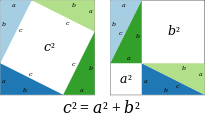
Bukti penyusunan
[sunting | sunting sumber]Dalam bukti penyusunan, dua persegi yang memiliki panjang sisi dan memuat empat segitiga siku-siku dengan dan adalah panjang sisinya, dan adalah hipotenusa. Pada persegi yang pertama, segitiga diletakkan sehingga tepi persegi sesuai dengan sudut siku-siku pada segitiga, dan membentuk sebuah persegi di tengahnya dengan panjang sisinya adalah . Masing-masing persegi mempunyai luas dan , dengan mewakili total luas dari keempat segitiga. Pada persegi yang kedua, keempat segitiga dibentuk menjadi dua persegi panjang dengan panjang sisi dan . Keempat segitiga tersebut diletakkan sehingga persegi dengan panjang sisi membentuk di tepi persegi, dan persegi dengan panjang sisi membentuk di tepi persegi lainnya. Persegi yang kedua akan mempunyai luas dan . Karena kedua persegi mempunyai luas , maka dapat dikatakan bahwa luas persegi juga sama dengan luas persegi lainnya sehingga = . Dengan menghilangkan luas dari keempat persegi pada kedua ruas persamaan akan memberikan rumus [2]
Dalam bukti lainnya, persegi panjang pada kotak kedua juga dapat diletakkan sehingga kedua persegi mempunyai sebuah tepi yang berpadanan dengan tepi persegi yang berurutan. Dalam hal ini juga dapat membentuk dua kotak, kali ini dalam bentuk persegi dengan tepi yang berurutan, dengan luas dan . Hal ini lagi mengacu pada persegi kdeua dengan luasnya .
Sir Thomas Heath, seorang matematikawan asal Inggris, memberikan bukti tersebut dalam komentarnya pada Proposisi I.47 dalam Euclid's Elements. Ia menyebutkan usulannya kepada matematikawan asal Jerman, Carl Anton Bretschneider dan Hermann Hankel, bahwa Pythagoras mungkin mengetahui bukti tersebut. Heath sendiri menyukai usulan yang berbeda mengenai bukti Pythagoras, tetapi Heath mengatakan permulaan diskusinya "bahwa kesusateraan Yunani yang kita miliki merupakan milik dari abad kelima pertama setelah Pythagoras tidak menyebutkan hal ini atau penemuan geometri besar lainnya kepadanya."[3] Pengetahuan terbaru ini telah menimbulkan keraguan yang semakin besar pada segala jenis peran untuk Pythagoras sebagai pencipta matematika, meskipun perdebatan berlanjut.[4]
Bukti melalui aljabar
[sunting | sunting sumber]Teorema Pythagoras dapat dibuktikan secara aljabar melalui empat salinan dari segitiga yang sama yang disusun secara simetris di sekitar persegi dengan sisi , seperti yang diperlihatkan pada gambar sebelumnya.[5] Hal ini menghasilkan sebuah persegi yang lebih besar, dengan sisi dan luas . Keempat segitiga dan persegi dengan sisi c harus mempunyai luas yang sama dengan luas persegi yang lebih besar, yang dirumuskan sebagai
Dengan menyusun ekspresi, memberikan
Ada bukti serupa yang menggunakan empat salinan dari segitiga siku-siku dengan sisi a, b dan c, yang disusun dalam sebuah persegi dengan sisi c seperti pada gambar sebelumnya.[6] Keempat segitiga tersebut sebangun dengan luasnya masing-masing sama dengan , sedangkan persegi yang kecil mempunyai sisi b − a dan luas (b − a)2. Karena itu, luas persegi dirumuskan
Namun hal ini merupakan sebuah persegi dengan sisi c dan luas c2, jadi
Bukti teorema Pythagoras lainnya
[sunting | sunting sumber]Teorema Pythagoras memiliki banyak bukti yang diketahui daripada teorema lainnya (seperti hukum reprositas kuadrat yang menyainginya berdasarkan jumlah bukti); buku The Pythagorean Proposition memiliki 370 bukti.[7]
Bukti menggunakan segitiga sebangun
[sunting | sunting sumber]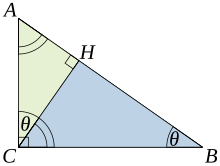
Bukti ini berdasarkan kesebandingan sisi yang sesuai pada dua segitiga yang sebangun. Dalam artian, bahwa perbandingan dua sisi yang sesuai dari segtiga yang sebangun sama terlepas dari ukuran segitiga.
Misalkan ABC adalah segitiga siku-siku, dengan C adalah sudut siku-siku. seperti yang diperlihatkan pada gambar di samping. Tariklah tinggi segitiga dari titik C hingga ke titik H, dimana H adalah titik perpotongan garis AB. Titik H membagi panjang hipotenusa c menjadi dua, yaitu d dan e. Segitiga baru ACH sebangun dengan segitiga ABC, karena kedua segitiga memiliki sudut siku-siku (menurut definisi tinggi segitiga). Kedua segitiga tersebut berbagi sudut A, dalam artian bahwa ada sudut ketiga juga akan sama pada kedua segitiga, yang ditandai dengan θ seperti pada gambar di samping. Dengan alasan yang serupa, segitiga CBH juga sebangun dengan ABC. Bukti kesebangunan dari segitiga-segitiga memerlukan postulat segitiga: Jumlah sudut dalam segitiga sama dengan dua kali sudut siku-siku, dan postulat ini ekuivalen dengan postulat kesejajaran. Kesebangunan segitiga mengacu pada persamaan dari perbandingan sisi:
- dan .
Hasil pertama pada persamaan di atas sama dengan kosinus sudut θ, sedangkan hasil kedua sama dengan sinus dari sudut θ. Kedua perbandingan tersebut dapat ditulis sebagai
- dan .
Dengan menjumlahkan kedua persamaan tersebut, akan menghasilkan persamaan
- .
Setelah penyederhanaan, persamaan tersebut menyatakan teorema Pythagoras:
- .
Peran bukti di atas dalam sejarah merupakan subjek yang memiliki banyak spekulasi. Pertanyaan mendasarnya adalah mengapa Euklides tidak menggunakan bukti tersebut, melainkan menemukan bukti lain. Salah satu dugaan adalah bahwa bukti melalui segitiga yang sebangun melibatkan teori kesebandingan, topik yang tidak membahas bukti tersebut hingga muncul Elements, dan teori kesebandingan tersebut membutuhkan pengembangan lebih lanjut pada masa itu.[8][9]
Bukti Euklides
[sunting | sunting sumber]
Secara garis besar, berikut adalah bagaimana bukti dalam Elements Euklides berasal. Persegi yang besar dibagi menjadi persegi panjang sebelah kiri dan kanan. Sebuah segitiga digambar sehingga memiliki luas persegi panjang di sebelah kiri. Lalu, sebuah segitiga lain digambar sehingga memiliki luas persegi panjang di sisi paling kiri. Kedua buah segitiga tersebut terbukti kongruen, dengan membuktikan bahwa persegi tersebut memiliki luas yang sama dengan persegi panjang sebelah kiri. Argumen ini diikuti oleh versi yang sama mengenai persegi panjang sebelah kanan dan persegi yang tersisa. Dengan menempatkan dua persegi panjang bersama-sama untuk membentuk persegi kembali pada sisi miring, maka luasnya sama dengan jumlah luas dari dua persegi lainnya. Bukti penjelasannya sebagai berikut:
Misalkan A, B, dan C adalah puncak segitiga siku-siku, dengan A adalah sudut siku-siku. Tarik garis suatu tegak lurus dari A ke sisi yang berhadapan dengan hipotenusa dalam persegi pada hipotenusa. Garis tersebut membagi persegi pada hipotenusa menjadi dua persegi panjang, masing-masing mempunyai luas yang sama seperti salah satu dari dua persegi pada kakinya.
Untuk bukti formalnya memerlukan empat lema dasar:
- Jika pada dua buah segitiga terdapat sepasang sisi di segitiga pertama sama panjang dengan sepasang sisi bersesuaian di segitiga kedua, dan sudut yang diapit kedua pasang sisi tersebut sama besar, maka dua segitiga tersebut kongruen (sisi-sudut-sisi).
- Luas dari segitiga sama dengan setengah dari luas suatu jajargenjang pada alas dan tinggi yang sama.
- Luas dari persegi panjang sama dengan hasil kali dari sisi damping.
- Luas dari persegi panjang sama dengan hasil kali dari dua sisi persegi panjang (diikuti dari lema 3).
Selanjutnya, setiap persegi di atas berkaitan dengan segitiga yang kongruen dengan segitiga lain yang berkaitan in turn to one of two rectangles making up the lower square.[10]
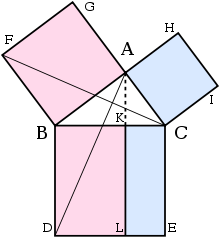
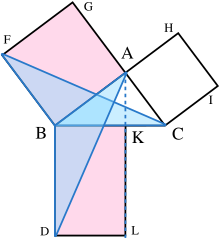
Berikut adalah buktinya:
- Misalkan ACB adalah segitiga bersudutkan siku-siku dengan sudut CAB adalah siku-siku.
- Pada setiap sisi BC, AB, dan CA, persegi CBDE, BAGF, dan ACIH digambar sesuai urutannya. Dalam Euclid Element, gambaran persegi ini memerlukan teorema dahulu dan juga bergantung pada postular sejajar.[11]
- Dari A, tariklah sebuah garis yang sejajar dengan BD dan CE. Garis tersebut tegak lurus dan memotong garis BC di K dan DE di L.
- Hubungkan garis CF dan AD sehingga membentuk segitiga BCF dan BDA.
- Sudut CAB dan BAG adalah siku-siku. Karena itu C, A, dan G kolinear.
- Sudut CBD dan FBA adalah siku-siku. Karena itu sudut ABD sama dengan sudut FBC, karena kedua sudut merupakan jumlah dari sudut siku-siku dan sudut ABC.
- Karena AB sama dengan FB, BD sama dengan BC dan sudut ABD sama dengan FBC, maka segitiga ABD harus kongruen dengan segitiga FBC.
- Karena titik A, K, dan L adalah garis lurus yang sejajar dengan BD, maka persegi panjang BDLK sama dengan dua kali dari luas segitiga ABD, karena mereka membagi alas BD dan mempunyai tinggi segitiga BK yang sama, yakni sebuah garis normal ke alas segitiga yang menghubungkan garis sejajar BD dan AL. (lema 2)
- Karena C kolinear dengan A dan G, dan garis CAG sejajar dengan FB, maka persegi BAGF harus dua kali dari luas segitiga FBC.
- Oleh karena itu, persegi panjang BDLK harus mempunyai luas yang sama seperti persegi BAGF = AB2.
- Dengan menerapkan dari langkah 3 ke 10 untuk sisi lain pada gambar berikut, hal ini dapat diperlihatkan dengan cara yang serupa bahwa persegi panjang CKLE harus mempunyai luas yang sama seperti ACIH = AC2.
- Dengan menambahkan kedua hasil tersebut, AB2 + AC2 = BD × BK + KL × KC.
- Karena BD = KL, maka BD × BK+ KL × KC = BD(BK + KC) = BD × BC.
- Oleh karena CBDE adalah persegi, maka AB2 + AC2 = BC2.
Bukti yang muncul dari Proposisi 47 dalam kitab Elements Euklides yang pertama, memperlihatkan bahwa luas persegi pada hipotenusa sama dengan jumlah dari luas dari dua persegi lainnya.[12][13] Bukti ini cukup berbeda dari bukti melalui kesebangunan segitiga, yang diduga merupakan bukti yang dipakai oleh Pythagoras.[14][15]
Bukti melalui pemisahan dan penyusunan ulang
[sunting | sunting sumber]Bukti lainnya adalah dengan menyusun ulang segitiga siku-siku seperti yang diperlihatkan pada animasi berikut. Sebuah persegi yang besar dibentuk dengan luas c2, dari empat segitiga siku-siku identik dengan sisi a, b dan c, dimuat di sekitar persegi berpusat yang kecil. Maka kedua persegi panjang dibentuk dengan sisi a dan b dengan memindahkan segitiga-segitiga tersebut. Dengan menggabungkan persegi yang lebih kecil dari persegi panjang tersebut menghasilkan dua persegi dengan luas masing-masing a2 dan b2, yang harus mempunyai luas yang sama dengan luas persegi besar yang awal.[16]

The third, rightmost image also gives a proof. The upper two squares are divided as shown by the blue and green shading, into pieces that when rearranged can be made to fit in the lower square on the hypotenuse – or conversely the large square can be divided as shown into pieces that fill the other two. This way of cutting one figure into pieces and rearranging them to get another figure is called dissection. This shows the area of the large square equals that of the two smaller ones.[17]
Bukti Einstein melalui pemisahan tanpa menyusun ulang
[sunting | sunting sumber]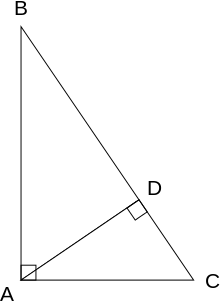
Albert Einstein gave a proof by dissection in which the pieces do not need to be moved.[18] Instead of using a square on the hypotenuse and two squares on the legs, one can use any other shape that includes the hypotenuse, and two similar shapes that each include one of two legs instead of the hypotenuse (see Similar figures on the three sides). In Einstein's proof, the shape that includes the hypotenuse is the right triangle itself. The dissection consists of dropping a perpendicular from the vertex of the right angle of the triangle to the hypotenuse, thus splitting the whole triangle into two parts. Those two parts have the same shape as the original right triangle, and have the legs of the original triangle as their hypotenuses, and the sum of their areas is that of the original triangle. Because the ratio of the area of a right triangle to the square of its hypotenuse is the same for similar triangles, the relationship between the areas of the three triangles holds for the squares of the sides of the large triangle as well.
Bukti aljabar
[sunting | sunting sumber]A related proof was published by future U.S. President James A. Garfield (then a U.S. Representative) (see diagram).[19][20][21] Instead of a square it uses a trapezoid, which can be constructed from the square in the second of the above proofs by bisecting along a diagonal of the inner square, to give the trapezoid as shown in the diagram. The area of the trapezoid can be calculated to be half the area of the square, that is
The inner square is similarly halved, and there are only two triangles so the proof proceeds as above except for a factor of , which is removed by multiplying by two to give the result.
Bukti melalui diferensial
[sunting | sunting sumber]One can arrive at the Pythagorean theorem by studying how changes in a side produce a change in the hypotenuse and employing calculus.[22][23][24]
The triangle ABC is a right triangle, as shown in the upper part of the diagram, with BC the hypotenuse. At the same time the triangle lengths are measured as shown, with the hypotenuse of length y, the side AC of length x and the side AB of length a, as seen in the lower diagram part.
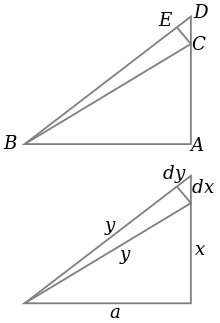
If x is increased by a small amount dx by extending the side AC slightly to D, then y also increases by dy. These form two sides of a triangle, CDE, which (with E chosen so CE is perpendicular to the hypotenuse) is a right triangle approximately similar to ABC. Therefore, the ratios of their sides must be the same, that is:
This can be rewritten as , which is a differential equation that can be solved by direct integration:
giving
The constant can be deduced from x = 0, y = a to give the equation
This is more of an intuitive proof than a formal one: it can be made more rigorous if proper limits are used in place of dx and dy.
Converse
[sunting | sunting sumber]The converse of the theorem is also true:[25]
For any three positive numbers a, b, and c such that a2 + b2 = c2, there exists a triangle with sides a, b and c, and every such triangle has a right angle between the sides of lengths a and b.
An alternative statement is:
For any triangle with sides a, b, c, if a2 + b2 = c2, then the angle between a and b measures 90°.
This converse also appears in Euclid's Elements (Book I, Proposition 48):[26]
"If in a triangle the square on one of the sides equals the sum of the squares on the remaining two sides of the triangle, then the angle contained by the remaining two sides of the triangle is right."
It can be proven using the law of cosines or as follows:
Let ABC be a triangle with side lengths a, b, and c, with a2 + b2 = c2. Construct a second triangle with sides of length a and b containing a right angle. By the Pythagorean theorem, it follows that the hypotenuse of this triangle has length c = √a2 + b2, the same as the hypotenuse of the first triangle. Since both triangles' sides are the same lengths a, b and c, the triangles are congruent and must have the same angles. Therefore, the angle between the side of lengths a and b in the original triangle is a right angle.
The above proof of the converse makes use of the Pythagorean theorem itself. The converse can also be proven without assuming the Pythagorean theorem.[27][28]
A corollary of the Pythagorean theorem's converse is a simple means of determining whether a triangle is right, obtuse, or acute, as follows. Let c be chosen to be the longest of the three sides and a + b > c (otherwise there is no triangle according to the triangle inequality). The following statements apply:[29]
- If a2 + b2 = c2, then the triangle is right.
- If a2 + b2 > c2, then the triangle is acute.
- If a2 + b2 < c2, then the triangle is obtuse.
Edsger W. Dijkstra has stated this proposition about acute, right, and obtuse triangles in this language:
- sgn(α + β − γ) = sgn(a2 + b2 − c2),
where α is the angle opposite to side a, β is the angle opposite to side b, γ is the angle opposite to side c, and sgn is the sign function.[30]
Consequences and uses of the theorem
[sunting | sunting sumber]Pythagorean triples
[sunting | sunting sumber]A Pythagorean triple has three positive integers a, b, and c, such that a2 + b2 = c2. In other words, a Pythagorean triple represents the lengths of the sides of a right triangle where all three sides have integer lengths.[31] Such a triple is commonly written (a, b, c). Some well-known examples are (3, 4, 5) and (5, 12, 13).
A primitive Pythagorean triple is one in which a, b and c are coprime (the greatest common divisor of a, b and c is 1).
The following is a list of primitive Pythagorean triples with values less than 100:
- (3, 4, 5), (5, 12, 13), (7, 24, 25), (8, 15, 17), (9, 40, 41), (11, 60, 61), (12, 35, 37), (13, 84, 85), (16, 63, 65), (20, 21, 29), (28, 45, 53), (33, 56, 65), (36, 77, 85), (39, 80, 89), (48, 55, 73), (65, 72, 97)
Reciprocal Pythagorean theorem
[sunting | sunting sumber]Given a right triangle with sides and altitude (a line from the right angle and perpendicular to the hypotenuse ). The Pythagorean theorem has,
while the reciprocal Pythagorean theorem[32] or the upside down Pythagorean theorem[33] relates the two legs to the altitude ,[34]
The equation can be transformed to,
where for any non-zero real . If the are to be integers, the smallest solution is then
using the smallest Pythagorean triple . The reciprocal Pythagorean theorem is a special case of the optic equation
where the denominators are squares and also for a heptagonal triangle whose sides are square numbers.
Incommensurable lengths
[sunting | sunting sumber]
One of the consequences of the Pythagorean theorem is that line segments whose lengths are incommensurable (so the ratio of which is not a rational number) can be constructed using a straightedge and compass. Pythagoras' theorem enables construction of incommensurable lengths because the hypotenuse of a triangle is related to the sides by the square root operation.
The figure on the right shows how to construct line segments whose lengths are in the ratio of the square root of any positive integer.[35] Each triangle has a side (labeled "1") that is the chosen unit for measurement. In each right triangle, Pythagoras' theorem establishes the length of the hypotenuse in terms of this unit. If a hypotenuse is related to the unit by the square root of a positive integer that is not a perfect square, it is a realization of a length incommensurable with the unit, such as √2, √3, √5 . For more detail, see Quadratic irrational.
Incommensurable lengths conflicted with the Pythagorean school's concept of numbers as only whole numbers. The Pythagorean school dealt with proportions by comparison of integer multiples of a common subunit.[36] According to one legend, Hippasus of Metapontum (ca. 470 B.C.) was drowned at sea for making known the existence of the irrational or incommensurable.[37][38]
Complex numbers
[sunting | sunting sumber]
For any complex number
the absolute value or modulus is given by
So the three quantities, r, x and y are related by the Pythagorean equation,
Note that r is defined to be a positive number or zero but x and y can be negative as well as positive. Geometrically r is the distance of the z from zero or the origin O in the complex plane.
This can be generalised to find the distance between two points, z1 and z2 say. The required distance is given by
so again they are related by a version of the Pythagorean equation,
Euclidean distance
[sunting | sunting sumber]The distance formula in Cartesian coordinates is derived from the Pythagorean theorem.[39] If (x1, y1) and (x2, y2) are points in the plane, then the distance between them, also called the Euclidean distance, is given by
More generally, in Euclidean n-space, the Euclidean distance between two points, and , is defined, by generalization of the Pythagorean theorem, as:
If instead of Euclidean distance, the square of this value (the squared Euclidean distance, or SED) is used, the resulting equation avoids square roots and is simply a sum of the SED of the coordinates:
The squared form is a smooth, convex function of both points, and is widely used in optimization theory and statistics, forming the basis of least squares.
Euclidean distance in other coordinate systems
[sunting | sunting sumber]If Cartesian coordinates are not used, for example, if polar coordinates are used in two dimensions or, in more general terms, if curvilinear coordinates are used, the formulas expressing the Euclidean distance are more complicated than the Pythagorean theorem, but can be derived from it. A typical example where the straight-line distance between two points is converted to curvilinear coordinates can be found in the applications of Legendre polynomials in physics. The formulas can be discovered by using Pythagoras' theorem with the equations relating the curvilinear coordinates to Cartesian coordinates. For example, the polar coordinates (r, θ) can be introduced as:
Then two points with locations (r1, θ1) and (r2, θ2) are separated by a distance s:
Performing the squares and combining terms, the Pythagorean formula for distance in Cartesian coordinates produces the separation in polar coordinates as:
using the trigonometric product-to-sum formulas. This formula is the law of cosines, sometimes called the generalized Pythagorean theorem.[40] From this result, for the case where the radii to the two locations are at right angles, the enclosed angle Δθ = π/2, and the form corresponding to Pythagoras' theorem is regained: The Pythagorean theorem, valid for right triangles, therefore is a special case of the more general law of cosines, valid for arbitrary triangles.
Pythagorean trigonometric identity
[sunting | sunting sumber]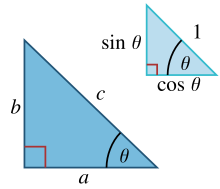
In a right triangle with sides a, b and hypotenuse c, trigonometry determines the sine and cosine of the angle θ between side a and the hypotenuse as:
From that it follows:
where the last step applies Pythagoras' theorem. This relation between sine and cosine is sometimes called the fundamental Pythagorean trigonometric identity.[41] In similar triangles, the ratios of the sides are the same regardless of the size of the triangles, and depend upon the angles. Consequently, in the figure, the triangle with hypotenuse of unit size has opposite side of size sin θ and adjacent side of size cos θ in units of the hypotenuse.
Relation to the cross product
[sunting | sunting sumber]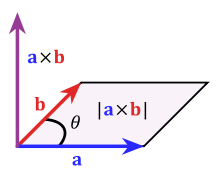
The Pythagorean theorem relates the cross product and dot product in a similar way:[42]
This can be seen from the definitions of the cross product and dot product, as
with n a unit vector normal to both a and b. The relationship follows from these definitions and the Pythagorean trigonometric identity.
This can also be used to define the cross product. By rearranging the following equation is obtained
This can be considered as a condition on the cross product and so part of its definition, for example in seven dimensions.[43][44]
Generalizations
[sunting | sunting sumber]Similar figures on the three sides
[sunting | sunting sumber]A generalization of the Pythagorean theorem extending beyond the areas of squares on the three sides to similar figures was known by Hippocrates of Chios in the 5th century BC,[45] and was included by Euclid in his Elements:[46]
If one erects similar figures (see Euclidean geometry) with corresponding sides on the sides of a right triangle, then the sum of the areas of the ones on the two smaller sides equals the area of the one on the larger side.
This extension assumes that the sides of the original triangle are the corresponding sides of the three congruent figures (so the common ratios of sides between the similar figures are a:b:c).[47] While Euclid's proof only applied to convex polygons, the theorem also applies to concave polygons and even to similar figures that have curved boundaries (but still with part of a figure's boundary being the side of the original triangle).[47]
The basic idea behind this generalization is that the area of a plane figure is proportional to the square of any linear dimension, and in particular is proportional to the square of the length of any side. Thus, if similar figures with areas A, B and C are erected on sides with corresponding lengths a, b and c then:
But, by the Pythagorean theorem, a2 + b2 = c2, so A + B = C.
Conversely, if we can prove that A + B = C for three similar figures without using the Pythagorean theorem, then we can work backwards to construct a proof of the theorem. For example, the starting center triangle can be replicated and used as a triangle C on its hypotenuse, and two similar right triangles (A and B ) constructed on the other two sides, formed by dividing the central triangle by its altitude. The sum of the areas of the two smaller triangles therefore is that of the third, thus A + B = C and reversing the above logic leads to the Pythagorean theorem a2 + b2 = c2. (See also Einstein's proof by dissection without rearrangement)
 |
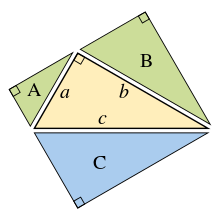 |
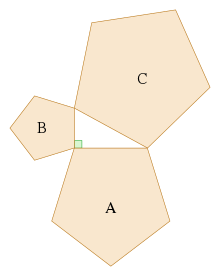 |
Law of cosines
[sunting | sunting sumber]
The Pythagorean theorem is a special case of the more general theorem relating the lengths of sides in any triangle, the law of cosines:[48]
where is the angle between sides and .
When is radians or 90°, then , and the formula reduces to the usual Pythagorean theorem.
Arbitrary triangle
[sunting | sunting sumber]
At any selected angle of a general triangle of sides a, b, c, inscribe an isosceles triangle such that the equal angles at its base θ are the same as the selected angle. Suppose the selected angle θ is opposite the side labeled c. Inscribing the isosceles triangle forms triangle CAD with angle θ opposite side b and with side r along c. A second triangle is formed with angle θ opposite side a and a side with length s along c, as shown in the figure. Thābit ibn Qurra stated that the sides of the three triangles were related as:[50][51]
As the angle θ approaches π/2, the base of the isosceles triangle narrows, and lengths r and s overlap less and less. When θ = π/2, ADB becomes a right triangle, r + s = c, and the original Pythagorean theorem is regained.
One proof observes that triangle ABC has the same angles as triangle CAD, but in opposite order. (The two triangles share the angle at vertex A, both contain the angle θ, and so also have the same third angle by the triangle postulate.) Consequently, ABC is similar to the reflection of CAD, the triangle DAC in the lower panel. Taking the ratio of sides opposite and adjacent to θ,
Likewise, for the reflection of the other triangle,
Clearing fractions and adding these two relations:
the required result.
The theorem remains valid if the angle is obtuse so the lengths r and s are non-overlapping.
General triangles using parallelograms
[sunting | sunting sumber]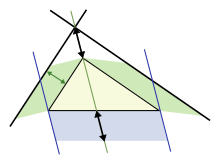

Pappus's area theorem is a further generalization, that applies to triangles that are not right triangles, using parallelograms on the three sides in place of squares (squares are a special case, of course). The upper figure shows that for a scalene triangle, the area of the parallelogram on the longest side is the sum of the areas of the parallelograms on the other two sides, provided the parallelogram on the long side is constructed as indicated (the dimensions labeled with arrows are the same, and determine the sides of the bottom parallelogram). This replacement of squares with parallelograms bears a clear resemblance to the original Pythagoras' theorem, and was considered a generalization by Pappus of Alexandria in 4 AD[52][53]
The lower figure shows the elements of the proof. Focus on the left side of the figure. The left green parallelogram has the same area as the left, blue portion of the bottom parallelogram because both have the same base b and height h. However, the left green parallelogram also has the same area as the left green parallelogram of the upper figure, because they have the same base (the upper left side of the triangle) and the same height normal to that side of the triangle. Repeating the argument for the right side of the figure, the bottom parallelogram has the same area as the sum of the two green parallelograms.
Solid geometry
[sunting | sunting sumber]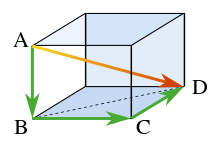

In terms of solid geometry, Pythagoras' theorem can be applied to three dimensions as follows. Consider a rectangular solid as shown in the figure. The length of diagonal BD is found from Pythagoras' theorem as:
where these three sides form a right triangle. Using horizontal diagonal BD and the vertical edge AB, the length of diagonal AD then is found by a second application of Pythagoras' theorem as:
or, doing it all in one step:
This result is the three-dimensional expression for the magnitude of a vector v (the diagonal AD) in terms of its orthogonal components {vk} (the three mutually perpendicular sides):
This one-step formulation may be viewed as a generalization of Pythagoras' theorem to higher dimensions. However, this result is really just the repeated application of the original Pythagoras' theorem to a succession of right triangles in a sequence of orthogonal planes.
A substantial generalization of the Pythagorean theorem to three dimensions is de Gua's theorem, named for Jean Paul de Gua de Malves: If a tetrahedron has a right angle corner (like a corner of a cube), then the square of the area of the face opposite the right angle corner is the sum of the squares of the areas of the other three faces. This result can be generalized as in the "n-dimensional Pythagorean theorem":[54]
Let be orthogonal vectors in ℝn. Consider the n-dimensional simplex S with vertices . (Think of the (n − 1)-dimensional simplex with vertices not including the origin as the "hypotenuse" of S and the remaining (n − 1)-dimensional faces of S as its "legs".) Then the square of the volume of the hypotenuse of S is the sum of the squares of the volumes of the n legs.
This statement is illustrated in three dimensions by the tetrahedron in the figure. The "hypotenuse" is the base of the tetrahedron at the back of the figure, and the "legs" are the three sides emanating from the vertex in the foreground. As the depth of the base from the vertex increases, the area of the "legs" increases, while that of the base is fixed. The theorem suggests that when this depth is at the value creating a right vertex, the generalization of Pythagoras' theorem applies. In a different wording:[55]
Given an n-rectangular n-dimensional simplex, the square of the (n − 1)-content of the facet opposing the right vertex will equal the sum of the squares of the (n − 1)-contents of the remaining facets.
Inner product spaces
[sunting | sunting sumber]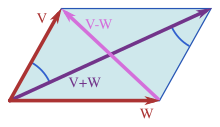
The Pythagorean theorem can be generalized to inner product spaces,[56] which are generalizations of the familiar 2-dimensional and 3-dimensional Euclidean spaces. For example, a function may be considered as a vector with infinitely many components in an inner product space, as in functional analysis.[57]
In an inner product space, the concept of perpendicularity is replaced by the concept of orthogonality: two vectors v and w are orthogonal if their inner product is zero. The inner product is a generalization of the dot product of vectors. The dot product is called the standard inner product or the Euclidean inner product. However, other inner products are possible.[58]
The concept of length is replaced by the concept of the norm ||v|| of a vector v, defined as:[59]
In an inner-product space, the Pythagorean theorem states that for any two orthogonal vectors v and w we have
Here the vectors v and w are akin to the sides of a right triangle with hypotenuse given by the vector sum v + w. This form of the Pythagorean theorem is a consequence of the properties of the inner product:
where the inner products of the cross terms are zero, because of orthogonality.
A further generalization of the Pythagorean theorem in an inner product space to non-orthogonal vectors is the parallelogram law :[59]
which says that twice the sum of the squares of the lengths of the sides of a parallelogram is the sum of the squares of the lengths of the diagonals. Any norm that satisfies this equality is ipso facto a norm corresponding to an inner product.[59]
The Pythagorean identity can be extended to sums of more than two orthogonal vectors. If v1, v2, ..., vn are pairwise-orthogonal vectors in an inner-product space, then application of the Pythagorean theorem to successive pairs of these vectors (as described for 3-dimensions in the section on solid geometry) results in the equation[60]
Sets of m-dimensional objects in n-dimensional space
[sunting | sunting sumber]Another generalization of the Pythagorean theorem applies to Lebesgue-measurable sets of objects in any number of dimensions. Specifically, the square of the measure of an m-dimensional set of objects in one or more parallel m-dimensional flats in n-dimensional Euclidean space is equal to the sum of the squares of the measures of the orthogonal projections of the object(s) onto all m-dimensional coordinate subspaces.[61]
In mathematical terms:
where:
- is a measure in m-dimensions (a length in one dimension, an area in two dimensions, a volume in three dimensions, etc.).
- is a set of one or more non-overlapping m-dimensional objects in one or more parallel m-dimensional flats in n-dimensional Euclidean space.
- is the total measure (sum) of the set of m-dimensional objects.
- represents an m-dimensional projection of the original set onto an orthogonal coordinate subspace.
- is the measure of the m-dimensional set projection onto m-dimensional coordinate subspace . Because object projections can overlap on a coordinate subspace, the measure of each object projection in the set must be calculated individually, then measures of all projections added together to provide the total measure for the set of projections on the given coordinate subspace.
- is the number of orthogonal, m-dimensional coordinate subspaces in n-dimensional space (Rn) onto which the m-dimensional objects are projected (m ≤ n):
Non-Euclidean geometry
[sunting | sunting sumber]The Pythagorean theorem is derived from the axioms of Euclidean geometry, and in fact, were the Pythagorean theorem to fail for some right triangle, then the plane in which this triangle is contained cannot be Euclidean. More precisely, the Pythagorean theorem implies, and is implied by, Euclid's Parallel (Fifth) Postulate.[62][63] Thus, right triangles in a non-Euclidean geometry[64] do not satisfy the Pythagorean theorem. For example, in spherical geometry, all three sides of the right triangle (say a, b, and c) bounding an octant of the unit sphere have length equal to π/2, and all its angles are right angles, which violates the Pythagorean theorem because .
Here two cases of non-Euclidean geometry are considered—spherical geometry and hyperbolic plane geometry; in each case, as in the Euclidean case for non-right triangles, the result replacing the Pythagorean theorem follows from the appropriate law of cosines.
However, the Pythagorean theorem remains true in hyperbolic geometry and elliptic geometry if the condition that the triangle be right is replaced with the condition that two of the angles sum to the third, say A+B = C. The sides are then related as follows: the sum of the areas of the circles with diameters a and b equals the area of the circle with diameter c.[65]
Spherical geometry
[sunting | sunting sumber]
For any right triangle on a sphere of radius R (for example, if γ in the figure is a right angle), with sides a, b, c, the relation between the sides takes the form:[66]
This equation can be derived as a special case of the spherical law of cosines that applies to all spherical triangles:
By expressing the Maclaurin series for the cosine function as an asymptotic expansion with the remainder term in big O notation,
it can be shown that as the radius R approaches infinity and the arguments a/R, b/R, and c/R tend to zero, the spherical relation between the sides of a right triangle approaches the Euclidean form of the Pythagorean theorem. Substituting the asymptotic expansion for each of the cosines into the spherical relation for a right triangle yields
The constants a4, b4, and c4 have been absorbed into the big O remainder terms since they are independent of the radius R. This asymptotic relationship can be further simplified by multiplying out the bracketed quantities, cancelling the ones, multiplying through by −2, and collecting all the error terms together:
After multiplying through by R2, the Euclidean Pythagorean relationship c2 = a2 + b2 is recovered in the limit as the radius R approaches infinity (since the remainder term tends to zero):
For small right triangles (a, b << R), the cosines can be eliminated to avoid loss of significance, giving
Hyperbolic geometry
[sunting | sunting sumber]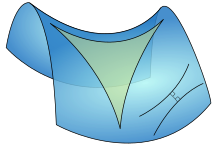
In a hyperbolic space with uniform curvature −1/R2, for a right triangle with legs a, b, and hypotenuse c, the relation between the sides takes the form:[67]
where cosh is the hyperbolic cosine. This formula is a special form of the hyperbolic law of cosines that applies to all hyperbolic triangles:[68]
with γ the angle at the vertex opposite the side c.
By using the Maclaurin series for the hyperbolic cosine, cosh x ≈ 1 + x2/2, it can be shown that as a hyperbolic triangle becomes very small (that is, as a, b, and c all approach zero), the hyperbolic relation for a right triangle approaches the form of Pythagoras' theorem.
For small right triangles (a, b << R), the hyperbolic cosines can be eliminated to avoid loss of significance, giving
Very small triangles
[sunting | sunting sumber]For any uniform curvature K (positive, zero, or negative), in very small right triangles (|K|a2, |K|b2 << 1) with hypotenuse c, it can be shown that
Differential geometry
[sunting | sunting sumber]
On an infinitesimal level, in three dimensional space, Pythagoras' theorem describes the distance between two infinitesimally separated points as:
with ds the element of distance and (dx, dy, dz) the components of the vector separating the two points. Such a space is called a Euclidean space. However, in Riemannian geometry, a generalization of this expression useful for general coordinates (not just Cartesian) and general spaces (not just Euclidean) takes the form:[69]
which is called the metric tensor. (Sometimes, by abuse of language, the same term is applied to the set of coefficients gij.) It may be a function of position, and often describes curved space. A simple example is Euclidean (flat) space expressed in curvilinear coordinates. For example, in polar coordinates:
History
[sunting | sunting sumber]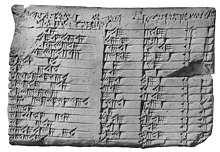
There is debate whether the Pythagorean theorem was discovered once, or many times in many places, and the date of first discovery is uncertain, as is the date of the first proof. Historians of Mesopotamian mathematics have concluded that the Pythagorean rule was in widespread use during the Old Babylonian period (20th to 16th centuries BC), over a thousand years before Pythagoras was born.[71][72][73][74] The history of the theorem can be divided into four parts: knowledge of Pythagorean triples, knowledge of the relationship among the sides of a right triangle, knowledge of the relationships among adjacent angles, and proofs of the theorem within some deductive system.
Written between 2000 and 1786 BC, the Egyptian Middle Kingdom Berlin Papyrus 6619 includes a problem whose solution is the Pythagorean triple 6:8:10, but the problem does not mention a triangle. The Mesopotamian tablet Plimpton 322, written between 1790 and 1750 BC during the reign of King Hammurabi the Great, contains many entries closely related to Pythagorean triples.
In India, the Baudhayana Shulba Sutra, the dates of which are given variously as between the 8th and 5th century BC,[75] contains a list of Pythagorean triples and a statement of the Pythagorean theorem, both in the special case of the isosceles right triangle and in the general case, as does the Apastamba Shulba Sutra (c. 600 BC).[a]
Byzantine Neoplatonic philosopher and mathematician Proclus, writing in the fifth century AD, states two arithmetic rules, "one of them attributed to Plato, the other to Pythagoras",[77] for generating special Pythagorean triples. The rule attributed to Pythagoras (ca 570–ca 495 BC) starts from an odd number and produces a triple with leg and hypotenuse differing by one unit; the rule attributed to Plato (428/427 or 424/423 – 348/347 BC) starts from an even number and produces a triple with leg and hypotenuse differing by two units. According to Thomas L. Heath (1861–1940), no specific attribution of the theorem to Pythagoras exists in the surviving Greek literature from the five centuries after Pythagoras lived.[78] However, when authors such as Plutarch and Cicero attributed the theorem to Pythagoras, they did so in a way which suggests that the attribution was widely known and undoubted.[79][80] Classicist Kurt von Fritz wrote, "Whether this formula is rightly attributed to Pythagoras personally, but one can safely assume that it belongs to the very oldest period of Pythagorean mathematics."[38] Around 300 BC, in Euclid's Elements, the oldest extant axiomatic proof of the theorem is presented.[81]
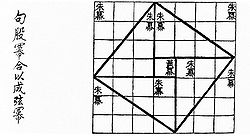
With contents known much earlier, but in surviving texts dating from roughly the 1st century BC, the Chinese text Zhoubi Suanjing (周髀算经), (The Arithmetical Classic of the Gnomon and the Circular Paths of Heaven) gives a reasoning for the Pythagorean theorem for the (3, 4, 5) triangle — in China it is called the "Gougu theorem" (勾股定理).[82][83] During the Han Dynasty (202 BC to 220 AD), Pythagorean triples appear in The Nine Chapters on the Mathematical Art,[84] together with a mention of right triangles.[85] Some believe the theorem arose first in China,[86] where it is alternatively known as the "Shang Gao theorem" (商高定理),[87] named after the Duke of Zhou's astronomer and mathematician, whose reasoning composed most of what was in the Zhoubi Suanjing.[88]
See also
[sunting | sunting sumber]- Addition in quadrature
- At Dulcarnon
- British flag theorem
- Fermat's Last Theorem
- Inverse Pythagorean theorem
- Kepler triangle
- Linear algebra
- List of triangle topics
- Lp space
- Nonhypotenuse number
- Parallelogram law
- Parseval's identity
- Ptolemy's theorem
- Pythagorean expectation
- Pythagorean tiling
- Rational trigonometry in Pythagoras' theorem
- Thales theorem
Catatan kaki dan rujukan
[sunting | sunting sumber]Catatan kaki
[sunting | sunting sumber]Rujukan
[sunting | sunting sumber]- ^ Judith D. Sally; Paul Sally (2007). "Chapter 3: Pythagorean triples". Roots to research: a vertical development of mathematical problems. American Mathematical Society Bookstore. hlm. 63. ISBN 978-0-8218-4403-8.
- ^ Benson, Donald. The Moment of Proof : Mathematical Epiphanies, pp. 172–173 (Oxford University Press, 1999).
- ^ (Euclid 1956), pp. 351–352
- ^ Huffman, Carl (23 February 2005). "Pythagoras". Dalam Zalta, Edward N. The Stanford Encyclopedia of Philosophy (Winter 2018 Edition)., "It should now be clear that decisions about sources are crucial in addressing the question of whether Pythagoras was a mathematician and scientist. The view of Pythagoras's cosmos sketched in the first five paragraphs of this section, according to which he was neither a mathematician nor a scientist, remains the consensus."
- ^ Alexander Bogomolny. "Cut-the-knot.org: Pythagorean theorem and its many proofs, Proof #4". Cut the Knot. Diakses tanggal 4 November 2010.
- ^ Alexander Bogomolny. "Cut-the-knot.org: Pythagorean theorem and its many proofs, Proof #3". Cut the Knot. Diakses tanggal 4 November 2010.
- ^ (Loomis 1968)
- ^ (Maor 2007, hlm. 39)
- ^ Stephen W. Hawking (2005). God created the integers: the mathematical breakthroughs that changed history. Philadelphia: Running Press Book Publishers. hlm. 12. ISBN 0-7624-1922-9. This proof first appeared after a computer program was set to check Euclidean proofs.
- ^ See for example Pythagorean theorem by shear mapping Diarsipkan 2016-10-14 di Wayback Machine., Saint Louis University website Java applet
- ^ Jan Gullberg (1997). Mathematics: from the birth of numbers
 . W. W. Norton & Company. hlm. 435. ISBN 0-393-04002-X.
. W. W. Norton & Company. hlm. 435. ISBN 0-393-04002-X.
- ^ Heiberg, J.L. "Euclid's Elements of Geometry" (PDF). hlm. 46–47.
- ^ "Euclid's Elements, Book I, Proposition 47".
web page version using Java applets from Euclid's Elements by Prof. David E. Joyce, Clark University
- ^ Kesalahan pengutipan: Tag
<ref>tidak sah; tidak ditemukan teks untuk ref bernamaHawking2 - ^ The proof by Pythagoras probably was not a general one, as the theory of proportions was developed only two centuries after Pythagoras; see (Maor 2007, hlm. 25)
- ^ Alexander Bogomolny. "Pythagorean theorem, proof number 10". Cut the Knot. Diakses tanggal 27 February 2010.
- ^ (Loomis 1968, hlm. 113, Geometric proof 22 and Figure 123)
- ^ Schroeder, Manfred Robert (2012). Fractals, Chaos, Power Laws: Minutes from an Infinite Paradise. Courier Corporation. hlm. 3–4. ISBN 978-0486134789.
- ^ Published in a weekly mathematics column: James A Garfield (1876). "Pons Asinorum". The New England Journal of Education. 3 (14): 161. as noted in William Dunham (1997). The mathematical universe: An alphabetical journey through the great proofs, problems, and personalities. Wiley. hlm. 96. ISBN 0-471-17661-3. and in A calendar of mathematical dates: April 1, 1876 Diarsipkan July 14, 2010, di Wayback Machine. by V. Frederick Rickey
- ^ Lantz, David. "Garfield's proof of the Pythagorean Theorem". Math.Colgate.edu. Diarsipkan dari versi asli tanggal 2013-08-28. Diakses tanggal 2018-01-14.
- ^ Maor, Eli, The Pythagorean Theorem, Princeton University Press, 2007: pp. 106-107.
- ^ Mike Staring (1996). "The Pythagorean proposition: A proof by means of calculus". Mathematics Magazine. Mathematical Association of America. 69 (1): 45–46. doi:10.2307/2691395. JSTOR 2691395.
- ^ Bogomolny, Alexander. "Pythagorean Theorem". Interactive Mathematics Miscellany and Puzzles. Alexander Bogomolny. Diarsipkan dari versi asli tanggal 2010-07-06. Diakses tanggal 2010-05-09.
- ^ Bruce C. Berndt (1988). "Ramanujan – 100 years old (fashioned) or 100 years new (fangled)?". The Mathematical Intelligencer. 10 (3): 24–31. doi:10.1007/BF03026638.
- ^ Judith D. Sally; Paul J. Sally Jr. (2007-12-21). "Theorem 2.4 (Converse of the Pythagorean theorem).". Roots to Research. American Mathematical Society. hlm. 54–55. ISBN 978-0-8218-4403-8.
- ^ Euclid's Elements, Book I, Proposition 48 From D.E. Joyce's web page at Clark University
- ^ Casey, Stephen, "The converse of the theorem of Pythagoras", Mathematical Gazette 92, July 2008, 309–313.
- ^ Mitchell, Douglas W., "Feedback on 92.47", Mathematical Gazette 93, March 2009, 156.
- ^ Ernest Julius Wilczynski; Herbert Ellsworth Slaught (1914). "Theorem 1 and Theorem 2". Plane trigonometry and applications. Allyn and Bacon. hlm. 85.
- ^ Dijkstra, Edsger W. (September 7, 1986). "On the theorem of Pythagoras". EWD975. E. W. Dijkstra Archive.
- ^ Kesalahan pengutipan: Tag
<ref>tidak sah; tidak ditemukan teks untuk ref bernamaSally02 - ^ R. B. Nelsen, Proof Without Words: A Reciprocal Pythagorean Theorem, Mathematics Magazine, 82, December 2009, p. 370
- ^ The upside-down Pythagorean theorem, Jennifer Richinick, The Mathematical Gazette, Vol. 92, No. 524 (July 2008), pp. 313-316
- ^ Alexander Bogomolny, Pythagorean Theorem for the Reciprocals,https://www.cut-the-knot.org/pythagoras/PTForReciprocals.shtml
- ^ Law, Henry (1853). "Corollary 5 of Proposition XLVII (Pythagoras's Theorem)". The Elements of Euclid: with many additional propositions, and explanatory notes, to which is prefixed an introductory essay on logic. John Weale. hlm. 49.
- ^ Shaughan Lavine (1994). Understanding the infinite. Harvard University Press. hlm. 13. ISBN 0-674-92096-1.
- ^ (Heath 1921, Vol I, pp. 65); Hippasus was on a voyage at the time, and his fellows cast him overboard. See James R. Choike (1980). "The pentagram and the discovery of an irrational number". The College Mathematics Journal. 11: 312–316.
- ^ a b A careful discussion of Hippasus's contributions is found in Kurt Von Fritz (Apr 1945). "The Discovery of Incommensurability by Hippasus of Metapontum". Annals of Mathematics. Second Series. 46 (2): 242–264. doi:10.2307/1969021. JSTOR 1969021.
- ^ Jon Orwant; Jarkko Hietaniemi; John Macdonald (1999). "Euclidean distance". Mastering algorithms with Perl. O'Reilly Media, Inc. hlm. 426. ISBN 1-56592-398-7.
- ^ Wentworth, George (2009). Plane Trigonometry and Tables. BiblioBazaar, LLC. hlm. 116. ISBN 978-1-103-07998-8., Exercises, page 116
- ^ Lawrence S. Leff (2005). PreCalculus the Easy Way
 (edisi ke-7th). Barron's Educational Series. hlm. 296. ISBN 0-7641-2892-2.
(edisi ke-7th). Barron's Educational Series. hlm. 296. ISBN 0-7641-2892-2.
- ^ WS Massey (Dec 1983). "Cross products of vectors in higher-dimensional Euclidean spaces" (PDF). The American Mathematical Monthly. Mathematical Association of America. 90 (10): 697–701. doi:10.2307/2323537. JSTOR 2323537. Diarsipkan dari versi asli (PDF) tanggal 2021-02-26.
- ^ Pertti Lounesto (2001). "§7.4 Cross product of two vectors". Clifford algebras and spinors (edisi ke-2nd). Cambridge University Press. hlm. 96. ISBN 0-521-00551-5.
- ^ Francis Begnaud Hildebrand (1992). Methods of applied mathematics (edisi ke-Reprint of Prentice-Hall 1965 2nd). Courier Dover Publications. hlm. 24. ISBN 0-486-67002-3.
- ^ Heath, T. L., A History of Greek Mathematics, Oxford University Press, 1921; reprinted by Dover, 1981.
- ^ Euclid's Elements: Book VI, Proposition VI 31: "In right-angled triangles the figure on the side subtending the right angle is equal to the similar and similarly described figures on the sides containing the right angle."
- ^ a b Putz, John F. and Sipka, Timothy A. "On generalizing the Pythagorean theorem", The College Mathematics Journal 34 (4), September 2003, pp. 291–295.
- ^ Lawrence S. Leff (2005-05-01). cited work. Barron's Educational Series. hlm. 326. ISBN 0-7641-2892-2.
- ^ Howard Whitley Eves (1983). "§4.8:...generalization of Pythagorean theorem". Great moments in mathematics (before 1650)
 . Mathematical Association of America. hlm. 41. ISBN 0-88385-310-8.
. Mathematical Association of America. hlm. 41. ISBN 0-88385-310-8.
- ^ Aydin Sayili (Mar 1960). "Thâbit ibn Qurra's Generalization of the Pythagorean Theorem". Isis. 51 (1): 35–37. doi:10.1086/348837. JSTOR 227603.
- ^ Judith D. Sally; Paul Sally (2007-12-21). "Exercise 2.10 (ii)". Roots to Research: A Vertical Development of Mathematical Problems. hlm. 62. ISBN 978-0-8218-4403-8.
- ^ For the details of such a construction, see George Jennings (1997). "Figure 1.32: The generalized Pythagorean theorem". Modern geometry with applications: with 150 figures
 (edisi ke-3rd). Springer. hlm. 23. ISBN 0-387-94222-X.
(edisi ke-3rd). Springer. hlm. 23. ISBN 0-387-94222-X.
- ^ Claudi Alsina, Roger B. Nelsen: Charming Proofs: A Journey Into Elegant Mathematics. MAA, 2010, ISBN 9780883853481, pp. 77–78 (excerpt, hlm. 77, pada Google Books)
- ^ Rajendra Bhatia (1997). Matrix analysis. Springer. hlm. 21. ISBN 0-387-94846-5.
- ^ For an extended discussion of this generalization, see, for example, Willie W. Wong Diarsipkan 2009-12-29 di Wayback Machine. 2002, A generalized n-dimensional Pythagorean theorem.
- ^ Ferdinand van der Heijden; Dick de Ridder (2004). Classification, parameter estimation, and state estimation. Wiley. hlm. 357. ISBN 0-470-09013-8.
- ^ Qun Lin; Jiafu Lin (2006). Finite element methods: accuracy and improvement. Elsevier. hlm. 23. ISBN 7-03-016656-6.
- ^ Howard Anton; Chris Rorres (2010). Elementary Linear Algebra: Applications Version (edisi ke-10th). Wiley. hlm. 336. ISBN 978-0-470-43205-1.
- ^ a b c Karen Saxe (2002). "Theorem 1.2". Beginning functional analysis. Springer. hlm. 7. ISBN 0-387-95224-1.
- ^ Douglas, Ronald G. (1998). Banach Algebra Techniques in Operator Theory (edisi ke-2nd). New York, New York: Springer-Verlag New York, Inc. hlm. 60–61. ISBN 978-0-387-98377-6.
- ^ Donald R Conant; William A Beyer (Mar 1974). "Generalized Pythagorean Theorem". The American Mathematical Monthly. Mathematical Association of America. 81 (3): 262–265. doi:10.2307/2319528. JSTOR 2319528.
- ^ Eric W. Weisstein (2003). CRC concise encyclopedia of mathematics (edisi ke-2nd). hlm. 2147. ISBN 1-58488-347-2.
The parallel postulate is equivalent to the Equidistance postulate, Playfair axiom, Proclus axiom, the Triangle postulate and the Pythagorean theorem.
- ^ Alexander R. Pruss (2006). The principle of sufficient reason: a reassessment. Cambridge University Press. hlm. 11. ISBN 0-521-85959-X.
We could include...the parallel postulate and derive the Pythagorean theorem. Or we could instead make the Pythagorean theorem among the other axioms and derive the parallel postulate.
- ^ Stephen W. Hawking (2005). cited work. hlm. 4. ISBN 0-7624-1922-9.
- ^ Victor Pambuccian (December 2010). "Maria Teresa Calapso's Hyperbolic Pythagorean Theorem". The Mathematical Intelligencer. 32 (4): 2. doi:10.1007/s00283-010-9169-0
 .
.
- ^ Barrett O'Neill (2006). "Exercise 4". Elementary differential geometry (edisi ke-2nd). Academic Press. hlm. 441. ISBN 0-12-088735-5.
- ^ Saul Stahl (1993). "Theorem 8.3". The Poincaré half-plane: a gateway to modern geometry. Jones & Bartlett Learning. hlm. 122. ISBN 0-86720-298-X.
- ^ Jane Gilman (1995). "Hyperbolic triangles". Two-generator discrete subgroups of PSL(2,R). American Mathematical Society Bookstore. ISBN 0-8218-0361-1.
- ^ Tai L. Chow (2000). Mathematical methods for physicists: a concise introduction. Cambridge University Press. hlm. 52. ISBN 0-521-65544-7.
- ^ Neugebauer 1969, hlm. 36.
- ^ Neugebauer 1969: p. 36 "In other words it was known during the whole duration of Babylonian mathematics that the sum of the squares on the lengths of the sides of a right triangle equals the square of the length of the hypotenuse."
- ^ Friberg, Jöran (1981). "Methods and traditions of Babylonian mathematics: Plimpton 322, Pythagorean triples, and the Babylonian triangle parameter equations". Historia Mathematica. 8: 277–318. doi:10.1016/0315-0860(81)90069-0
 .: p. 306 "Although Plimpton 322 is a unique text of its kind, there are several other known texts testifying that the Pythagorean theorem was well known to the mathematicians of the Old Babylonian period."
.: p. 306 "Although Plimpton 322 is a unique text of its kind, there are several other known texts testifying that the Pythagorean theorem was well known to the mathematicians of the Old Babylonian period."
- ^ Høyrup, Jens. "Pythagorean 'Rule' and 'Theorem' – Mirror of the Relation Between Babylonian and Greek Mathematics". Dalam Renger, Johannes. Babylon: Focus mesopotamischer Geschichte, Wiege früher Gelehrsamkeit, Mythos in der Moderne. 2. Internationales Colloquium der Deutschen Orient-Gesellschaft 24.–26. März 1998 in Berlin (PDF). Berlin: Deutsche Orient-Gesellschaft / Saarbrücken: SDV Saarbrücker Druckerei und Verlag. hlm. 393–407., p. 406, "To judge from this evidence alone it is therefore likely that the Pythagorean rule was discovered within the lay surveyors’ environment, possibly as a spin-off from the problem treated in Db2-146, somewhere between 2300 and 1825 BC." (Db2-146 is an Old Babylonian clay tablet from Eshnunna concerning the computation of the sides of a rectangle given its area and diagonal.)
- ^ Robson, E. (2008). Mathematics in Ancient Iraq: A Social History. Princeton University Press.: p. 109 "Many Old Babylonian mathematical practitioners … knew that the square on the diagonal of a right triangle had the same area as the sum of the squares on the length and width: that relationship is used in the worked solutions to word problems on cut-and-paste ‘algebra’ on seven different tablets, from Ešnuna, Sippar, Susa, and an unknown location in southern Babylonia."
- ^ Kim Plofker (2009). Mathematics in India. Princeton University Press. hlm. 17–18. ISBN 978-0-691-12067-6.
- ^ Carl Benjamin Boyer; Uta C. Merzbach (2011). "China and India". A history of mathematics (edisi ke-3rd). Wiley. hlm. 229. ISBN 978-0470525487.
Quote: [In Sulba-sutras,] we find rules for the construction of right angles by means of triples of cords the lengths of which form Pythagorean triages, such as 3, 4, and 5, or 5, 12, and 13, or 8, 15, and 17, or 12, 35, and 37. Although Mesopotamian influence in the Sulvasũtras is not unlikely, we know of no conclusive evidence for or against this. Aspastamba knew that the square on the diagonal of a rectangle is equal to the sum of the squares on the two adjacent sides. Less easily explained is another rule given by Apastamba – one that strongly resembles some of the geometric algebra in Book II of Euclid's Elements. (...)
- ^ Proclus (1970). A Commentary of the First Book of Euclid's Elements. Diterjemahkan oleh Morrow, Glenn R. Princeton University Press. 428.6.
- ^ (Euclid 1956, hlm. 351) page 351
- ^ (Heath 1921, Vol I, p. 144): "Though this is the proposition universally associated by tradition with the name of Pythagoras, no really trustworthy evidence exists that it was actually discovered by him. The comparatively late writers who attribute it to him add the story that he sacrificed an ox to celebrate his discovery."
- ^ An extensive discussion of the historical evidence is provided in (Euclid 1956, hlm. 351) page=351
- ^ Asger Aaboe (1997). Episodes from the early history of mathematics. Mathematical Association of America. hlm. 51. ISBN 0-88385-613-1.
...it is not until Euclid that we find a logical sequence of general theorems with proper proofs.
- ^ Robert P. Crease (2008). The great equations: breakthroughs in science from Pythagoras to Heisenberg. W W Norton & Co. hlm. 25. ISBN 978-0-393-06204-5.
- ^ A rather extensive discussion of the origins of the various texts in the Zhou Bi is provided by Christopher Cullen (2007). Astronomy and Mathematics in Ancient China: The 'Zhou Bi Suan Jing'. Cambridge University Press. hlm. 139 ff. ISBN 978-0-521-03537-8.
- ^ This work is a compilation of 246 problems, some of which survived the book burning of 213 BC, and was put in final form before 100 AD. It was extensively commented upon by Liu Hui in 263 AD. Philip D. Straffin Jr. (2004). "Liu Hui and the first golden age of Chinese mathematics". Dalam Marlow Anderson; Victor J. Katz; Robin J. Wilson. Sherlock Holmes in Babylon: and other tales of mathematical history. Mathematical Association of America. hlm. 69 ff. ISBN 0-88385-546-1. See particularly §3: Nine chapters on the mathematical art, pp. 71 ff.
- ^ Kangshen Shen; John N. Crossley; Anthony Wah-Cheung Lun (1999). The nine chapters on the mathematical art: companion and commentary. Oxford University Press. hlm. 488. ISBN 0-19-853936-3.
- ^ In particular, Li Jimin; see Centaurus, Volume 39. Copenhagen: Munksgaard. 1997. hlm. 193, 205.
- ^ Chen, Cheng-Yih (1996). "§3.3.4 Chén Zǐ's formula and the Chóng-Chã method; Figure 40". Early Chinese work in natural science: a re-examination of the physics of motion, acoustics, astronomy and scientific thoughts. Hong Kong University Press. hlm. 142. ISBN 962-209-385-X.
- ^ Wen-tsün Wu (2008). "The Gougu theorem". Selected works of Wen-tsün Wu. World Scientific. hlm. 158. ISBN 978-981-279-107-8.
Kutipan
[sunting | sunting sumber]- Loomis, Elisha Scott (1968). The Pythagorean proposition (edisi ke-2nd). The National Council of Teachers of Mathematics. ISBN 978-0-87353-036-1. For full text of 2nd edition of 1940, see Elisha Scott Loomis. "The Pythagorean proposition: its demonstrations analyzed and classified, and bibliography of sources for data of the four kinds of proofs" (PDF). Education Resources Information Center. Institute of Education Sciences (IES) of the U.S. Department of Education. Diakses tanggal 2010-05-04. Originally published in 1940 and reprinted in 1968 by National Council of Teachers of Mathematics, ISBN 0-87353-036-5.
Kesalahan pengutipan: Ditemukan tag <ref> untuk kelompok bernama "lower-alpha", tapi tidak ditemukan tag <references group="lower-alpha"/> yang berkaitan




























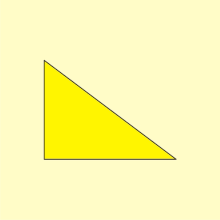












































































![{\displaystyle 1-{\frac {1}{2}}\left({\frac {c}{R}}\right)^{2}+O\left({\frac {1}{R^{4}}}\right)=\left[1-{\frac {1}{2}}\left({\frac {a}{R}}\right)^{2}+O\left({\frac {1}{R^{4}}}\right)\right]\left[1-{\frac {1}{2}}\left({\frac {b}{R}}\right)^{2}+O\left({\frac {1}{R^{4}}}\right)\right]{\text{ as }}R\to \infty \ .}](https://wikimedia.org/api/rest_v1/media/math/render/svg/9ab88b5e5c1da838bc94164e6cbdd8f54d6e8035)









